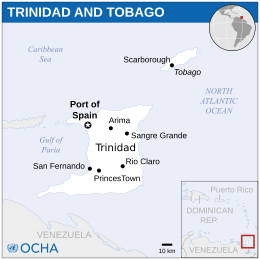Republic of Trinidad and Tobago: Difference between revisions
From ProleWiki, the proletarian encyclopedia
More languages
More actions
(WW2) Tag: Visual edit |
General-KJ (talk | contribs) m (Added category) Tag: Visual edit |
||
| (One intermediate revision by the same user not shown) | |||
| Line 4: | Line 4: | ||
== History == | == History == | ||
In September 1940, [[Winston Churchill]] agreed to lease military bases in Trinidad and other [[Colonialism|colonies]] in exchange for using old U.S. destroyers.<ref name=":0222">{{Citation|author=David Vine|year=2020|title=The United States of War|chapter=Reopening the Frontier|page=|city=Oakland|publisher=University of California Press|isbn=9780520972070|lg=http://library.lol/main/191568BFAC73F009132DB00ECD0F0F05}}</ref><sup>:222</sup> The [[United States of America|United States]] spent $82 million on its military base and paid local construction workers much less than U.S. citizens. By 1943, there were almost 21,000 soldiers and sailors on the base. It used the base to counter [[German Reich (1933–1945)|German]] submarine attacks. After the war, Prime Minister [[Eric Williams]] criticized the deal for " | In September 1940, [[Winston Churchill]] agreed to lease military bases in Trinidad and other [[Colonialism|colonies]] in exchange for using old U.S. destroyers.<ref name=":0222">{{Citation|author=David Vine|year=2020|title=The United States of War|chapter=Reopening the Frontier|page=|city=Oakland|publisher=University of California Press|isbn=9780520972070|lg=http://library.lol/main/191568BFAC73F009132DB00ECD0F0F05}}</ref><sup>:222</sup> The [[United States of America|United States]] spent $82 million on its military base and paid local construction workers much less than U.S. citizens. By 1943, there were almost 21,000 soldiers and sailors on the base. It used the base to counter [[German Reich (1933–1945)|German]] submarine attacks. After the war, Prime Minister [[Eric Williams]] criticized the deal for "selling [Trinidad and Tobago] for scrap" because only nine of the 50 destroyers actually worked.<ref name=":0222" /><sup>:235–6</sup> | ||
== References == | == References == | ||
[[Category:Countries]] | |||
[[Category:North American countries]] | [[Category:North American countries]] | ||
{{DEFAULTSORT:Trinidad_and_Tobago}} | {{DEFAULTSORT:Trinidad_and_Tobago}} | ||
Latest revision as of 10:53, 10 January 2024
| Republic of Trinidad and Tobago | |
|---|---|
 | |
| Capital | Port of Spain |
| Largest city | San Fernando |
| Dominant mode of production | Capitalism |
| Area | |
• Total | 5,131 km² |
| Population | |
• 2022 estimate | 1,405,646 |
Trinidad and Tobago, officially the Republic of Trinidad and Tobago, is an island country in the Caribbean.
History[edit | edit source]
In September 1940, Winston Churchill agreed to lease military bases in Trinidad and other colonies in exchange for using old U.S. destroyers.[1]:222 The United States spent $82 million on its military base and paid local construction workers much less than U.S. citizens. By 1943, there were almost 21,000 soldiers and sailors on the base. It used the base to counter German submarine attacks. After the war, Prime Minister Eric Williams criticized the deal for "selling [Trinidad and Tobago] for scrap" because only nine of the 50 destroyers actually worked.[1]:235–6
References[edit | edit source]
- ↑ Jump up to: 1.0 1.1 David Vine (2020). The United States of War: 'Reopening the Frontier'. Oakland: University of California Press. ISBN 9780520972070 [LG]


